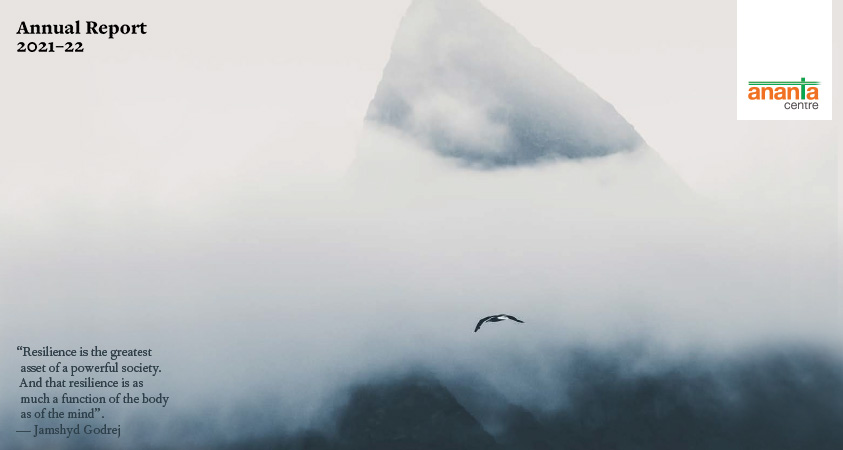India being a country with a vibrant and diverse economy has immense potential to grow and tap into opportunities by addressing issues that have enthralled its economic activities in recent times. As India emerges from the second wave of the pandemic, its economy has been affected immensely. To understand the severity, impact, challenges and the growth prospects, the Ananta Centre organized a session on The Growth Prospect after the second COVID wave –Taking Stock of the Indian Economy, with one of the best economic minds in the country namely- Dr. Ila Patnaik, Professor National Institute of Public Finance and Policy; Dr. Naushad Forbes, Co-Chairman Forbes Marshall and Chairman, Ananta Aspen Centre and Dr. Nitin Desai, Chairman, The Energy & Resource Institute and Trustee, Ananta Centre, moderated by AK Bhattacharya Editorial Director, Business Standard.
India’s growth in 2020 was contracted by 24%, with a nation wide lockdown, and lesser movement in economic activity. Individuals and companies did not have the means and plans in place to combat the pandemic and were unprepared.
This year things have changed for the better, with increased government support, structured lockdowns, economic activity not coming to an absolute halt and companies initiating to vaccinate their employees, growth is likely to bounce back as restrictions ease.
According to the Centre for Monitoring Indian Economy, covid-19 has eroded India’s consumption down to the 2017-18 levels. Employment rates have declined by almost 10%, partial lockdowns in the worst hit regions of the country have encouraged consumers to hold cash which has had an impact on consumer spending and sentiments. The numbers have tumbled dramatically between the months of March and May 2021 as the country was ravaged by the second wave of the
pandemic and the fear of a potential third wave has further made people conserve cash.
The government in order to increase consumer spending must restore their confidence in the healthcare system to solve this conundrum. Vaccination and strengthening the healthcare system can help define the growth in the next few years and, as the drive progresses, India plans to inoculate 10 million people daily and success on the healthcare front will be soon seen on the economic front as well.
The two areas that require great attention are healthcare and education which need to be addressed at the earliest, as these sectors especially in the rural areas are the most vulnerable to the current effects and aftermath of the pandemic. They must be corrected with reforms and changes by the public sector as this will give a boost to consumption and confidence of the consumers.
Government spending may be limited due to rise in debt ratio and increasing inflation. Certain areas can be re-examined and managed much more efficiently with greater cooperation between the center and the state governments.
It is estimated that 25 million jobs have been lost in the second wave. In order to revive the prospects of employment, there are two direct paths that can be taken up by the Union and State governments. Paying dues to states and indirectly funding and implementing their infrastructure programs or by directly injecting money into the economy from a policy perspective, to enhance both liquidity and employment in the country.
One of the measures taken up by the government has been disinvestment from loss making entities and privatizing them. This privatization program requires further cooperation within the ministries and focus on substantial structural reforms as it can be turned into an opportunity to facilitate growth.
Today the need of the hour is to restore the confidence of consumers as people in the country are increasingly conserving cash. At this point there is a requirement to increase investment, essentially private investment and a monetary policy regime, to facilitate investment.
Cash transfers must continue as mitigating them can worsen the confidence of consumers. Long run cash transfers can draw a comparison between price distortion and income support, but price distortions in the long run may give a wrong production output and may not give an optimal allocation of reasonable resources.
Apath to choose in order to assist rural India is either by price distortions or income support.
Today in the agricultural sector cash transfers and price support both exist which were introduced in the 1960s in order to encourage wheat and rice cultivation which continues to increase till today in an aggressive fashion. Cash transfers or subsidies cannot be treated as substitutes for structural changes which are required in today’s economy. People should be encouraged to look at the example of white revolution which had neither cash transfers nor price support but worked through a structural system as urban markets were captured by rural cooperatives and income went directly in the hands of the farmers.
The Government in order to combat these challenges and aid the growth and development of the economy, needs to restore the confidence of its citizens in the healthcare and education system, which has been ravaged by the second wave of the pandemic. Mitigating unemployment and taking up infrastructural reforms such as bailing out stressed sectors and public sector undertakings by facilitating privatization is key.
To watch the session click here:-






















